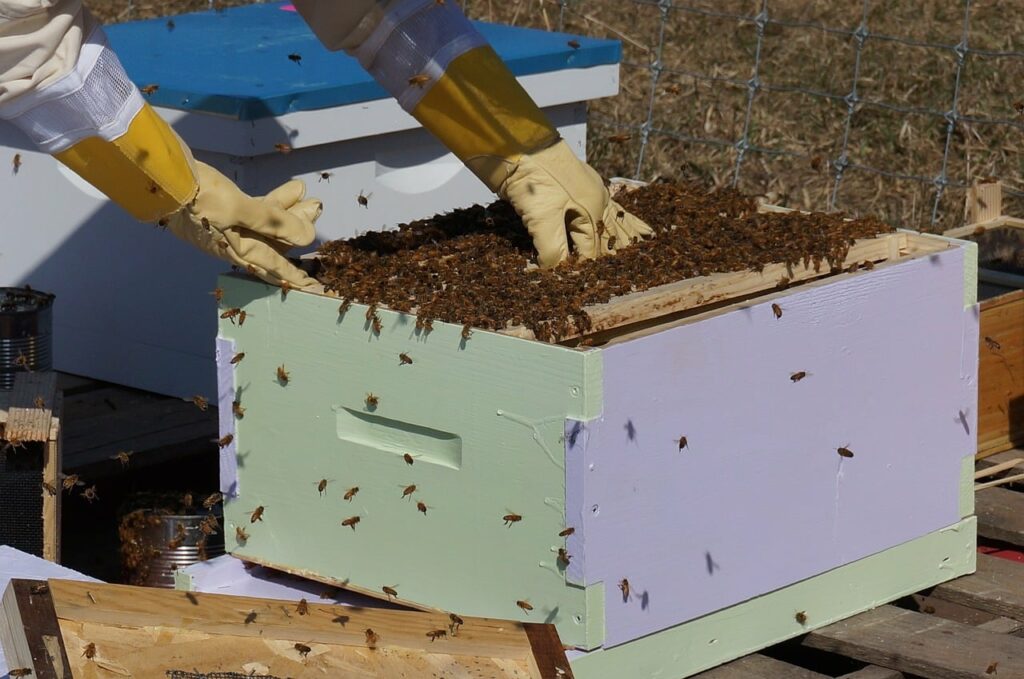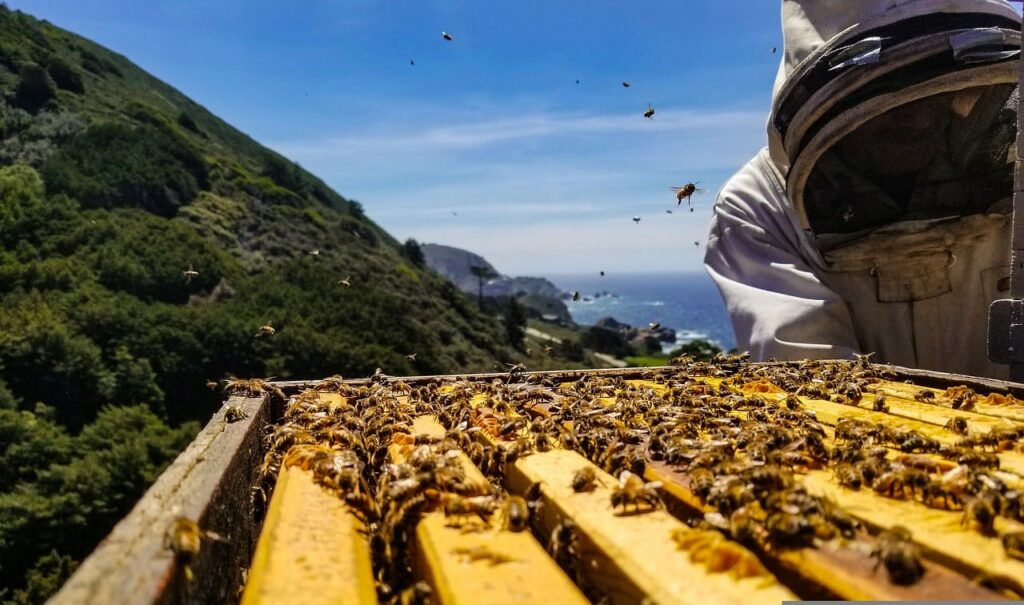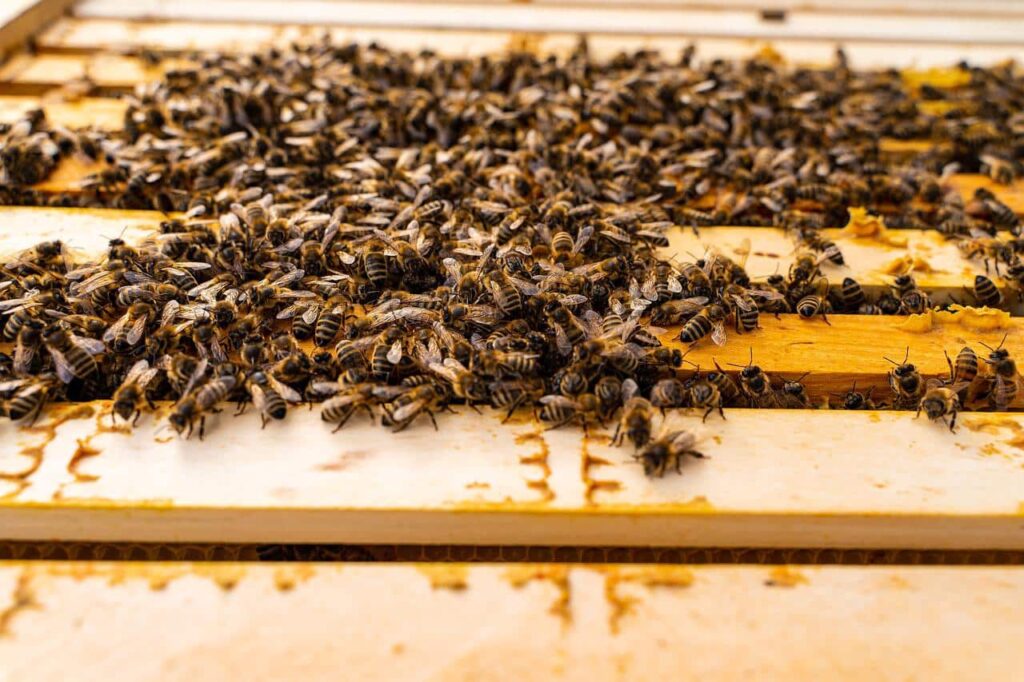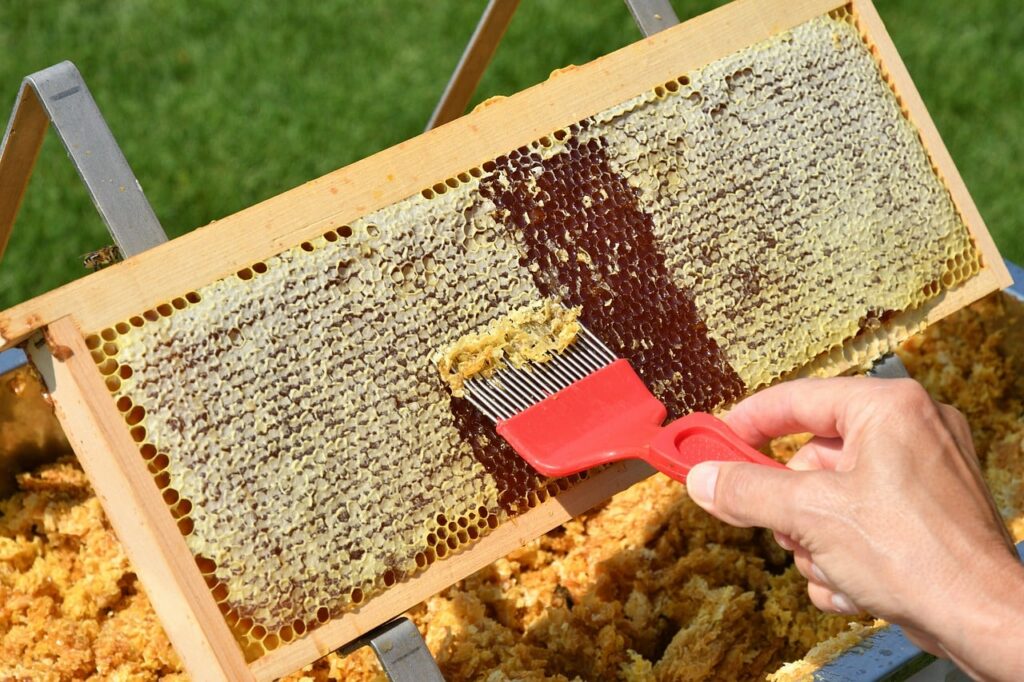Do you love the taste of honey? Do you want to learn more about how bees make honey? If so, then beekeeping might be the hobby for you!
But first, we want to welcome those joining us from beesreview.com! We have recently acquired the site and look forward to sharing our tips and knowledge on all aspects of beekeeping.
Beekeeping is a fascinating and rewarding activity that allows you to get up close and personal with these amazing creatures. In this article, we will discuss the basics of beekeeping, from why you might want to become a beekeeper to what equipment you will need. We’ll also talk about different types of hives and bees, common bee diseases and pests, honey production and how to harvest honey. So, if you’re interested in becoming a beekeeper, keep reading!

Why Become a Beekeeper?
There are many reasons why you might want to become a beekeeper. For one, it’s a great way to produce your own honey! Beekeepers can also sell their honey at farmers markets or online, making beekeeping a lucrative hobby. Additionally, beekeeping is a great way to learn about the natural world and help the environment. By keeping bees, you can help to pollinate crops and gardens, and you may even be able to help reverse the decline of bee populations in your area.
Courses and Training
If you’re interested in becoming a beekeeper, there are many courses and training programs available to help you get started. Many local beekeeping associations offer beginner courses that will teach you the basics of beekeeping. Additionally, many online resources such as YouTube channels, eBooks and websites offer helpful information for new beekeepers.
Types of Beehives
There are several different types of beehives that you can use for your bees. The most common type is the Langstroth hive1, which is a box hive that consists of several frames. Langstroth hives are easy to use and maintain, making them a good choice for beginner beekeepers.
Another popular type of hive is the top bar hive or Kenyan hive, which is a little bit similar to the Langstroth hive but has only one level and only the ‘top bar’ of a frame is used, upon which the bees can more naturally build their comb down from. Top bar hives are less expensive and easier to build than Langstroth hives, making them a good choice for those who are on a budget and are also quite gentle on the bees. It can be difficult to harvest honey from a top bar hive though, as frequently brood and honey are intermixed (unless a queen excluder is introduced to separate part of the top bar hive for workers only)
Flow hives2 are a newer type of hive that is becoming increasingly popular among beekeepers. Flow hives allow you to harvest honey without opening the hive, which is less stressful for the bees. Additionally, flow hives are easier to use than traditional hives, making them a good choice for beginner beekeepers. Flow hives are the most expensive type of hive due to the complex mechanical construction of the honey super.

Different Types of Bees
Inside a hive and within honey bee colonies, there are different types of Bees. Each bee has a special role3 within the colony.
- Queen bee: The Queen bee lays the eggs (called brood) and chooses which ones to fertilise.
- Eggs: Eggs are laid by the queen and are almost too small to be seen, like a tiny grain of rice. Fertilised eggs grow up to be female bees (either worker or a new queen), and unfertilised eggs grow up to be male Drone bees.
- Larvae: these hatch from the eggs and are fed a mix of Royal Jelly produced by worker bees, as well as pollen and honey. If a larvae is fed solely Royal Jelly, it will turn into a queen. The larvae look like a little grubs, and will molt several times before creating a cocoon and pupating
- Pupae: they are the stage of bee that are encased in a cocoon and are pupating into adult bees
- Young Nurse bees: these are newly hatched bee pupae that work inside to clean the hive and tend to the larvae, feeding them royal jelly, pollen and honey.
- Worker bees: Once a young bees royal jelly producing glands wear out, they switch from nursing duties to construction and begin building honeycomb using their wax secretions from their body, as well as receiving nectar and pollen from foragers and using it to make and store honey
- Forager bees: Once a worker bee is grown to its full size it will take its first orientation flight and join the rest of the colonies foragers to go and look for nectar, pollen and water to bring back to the hive. Bees communicate with intricate dances and shakes to indicate the angle from the sun and distance to move from the hive to find food.
- Drone bees: Drone bees are male bees. They are a bit useless and kind of just hang around and get fed by the nurse bees. Drone bees wait around for the right conditions for virgin queens to take their maiden flights, and if they get a whiff of her pheromones they will chase her until they literally die. (Yes, Drones die after mating with a Virgin queen similar to how a bee dies after it stings you). If a colony is under duress or running out of food, the worker bees will force the Drones out of the hive to die.
- Virgin Queens. Virgin queens are sometimes grown in spring time when the hive wishes to swarm – the Virgin queens will firstly attempt to kill other hatching virgin queens, and then will go off on a waiting flight, to mate with as many Drone bees as possible (queens will not mate with Drones from their own hive). After the Queen has collected the sperm, she will return to her hive and take half of the worker bees to go off and find a new place to find a hive.
“It is the thousands of worker bees who keep the colony going. From the day they are born they slave away without complaining; cleaning and guarding the hive, feeding the developing bee brood (babies), building the honeycomb, and collecting nectar to process into honey stores for the long winter when there are no flowers. The workers keep the hive cool in summer and warm in winter. And they communicate very efficiently too – they can tell their sisters where to find the best flowers, and the amount and quality of the nectar they will find there. They can tell if the queen is safe and if that new bee trying to creep in is a stranger from another hive coming to steal their precious honey.”
mdbka.com/bee-information3
Different species of Honey Bees
There are 8 different species of honey bees4 with 43 subspecies, but the most common breed of honey bee used for beekeeping are the Italian bee, specifically the Ligurian bee and the Carniolan bee (but Lugarian are more common). Italian bees are gentle and easy to work with, with good hone-producing qualities making them a good choice for beginner beekeepers. Carniolan bees are a hardy breed of bee and can withstand colder climates. They are also less likely to swarm than other types of bees.
Common Bee Diseases and Pests
Bees are susceptible to diseases and pests, just like any other animal.
- Varroa mites5 are one of the most common and dangerous pests around the world, as they attach themselves to bees and suck their blood, weakening them and making them more susceptible to other diseases. They are responsible for the destruction of huge numbers of hives, and should be carefully guarded for
- American foulbrood is a disease that infects bee larvae, causing them to die before they can pupate.
- European foulbrood is another disease that affects bee larvae, but is not as serious as American foulbrood and can be treated with antibiotics.
- Chalkbrood is a fungal disease that affects bee larvae, causing them to die and turn into hard, black fungus.
- Nosema is a disease that affects the gut of bees and can cause them to stop eating and eventually die.
- Hive moth larvae are tiny caterpillars that live in beehives and eat the beeswax, honey and pollen.
- Wax moth larvae are similar to hive moth larvae but they don’t usually cause as much damage to the hive as they try to
- Small hive beetles are a type of beetle that infests beehives and feeds on the beeswax, honey and pollen.
- Pesticides are also a big threat to bees as they can contaminate the pollen and nectar that bees collect from flowers.
How to Manage Your Hives from Pest and Diseases
The best way to prevent your hives from getting pests and diseases is to buy bees that are already resistant to them, and to keep your bee hives clean. You should also do regular hive inspections to check for signs of pests or diseases, and if you find anything, you should treat it immediately.
If you have varroa mites, you should use a varroa mite treatment such as Apivar or Formic Pro. You also need to notify your beekeeping authority about this infection. If you have American foulbrood, you should burn the affected hive and start again with new bees. If you have European foulbrood, you can treat it with antibiotics. If you have chalkbrood, you should remove the affected larvae from the hive and incinerate them.
If you have nosema, you can treat it with Fumagillin. If you have hive moth larvae, you should remove them from the hive and destroy them. If you have wax moth larvae, you can try to remove as many as possible but with a strong colony they will usually not do much damage to the hive and the bees will clear them out so you don’t need to worry about them as much. If you have small hive beetles, you can use a beetle trap such as the Beetle Blaster or the BeeGoBeetle.
You should also avoid using pesticides near your hives as they can contaminate the pollen and nectar that bees collect from flowers.

Doing a Hive Inspection6
A bee hive inspection is when you open up the hive and look inside to check on the bees and make sure everything is okay. You should do a hive inspection every few weeks during the peak beekeeping season which is late spring to summer
To do a hive inspection, you will need to put on your bee suit, veil and gloves. You will also need a smoker and a hive tool. The smoker helps to keep the bees calm while you are working on the hive. The hive tool is used to pry open the frames so you can take a look inside.
Start by lighting the smoker and smoking around the entrance of the hive. This will help to keep the bees calm while you are working. Then, use your hive tool to pry open the lid of the hive. Be careful not to squish any bees!
Once you have the lid off, take out the second frame from the edge and carefully slide it up and out, and then hang it on your frame holder on the side of the hive. Before you place it down, have a look at the frame. Then take out the next one.
You are looking for three things: brood, honey and pollen. The brood is where the baby bees are being raised. The honey is the food that the bees have collected, and the pollen is used to feed the larvae.
If you find any pests or diseases, you should treat them immediately. Otherwise, everything looks good! You can put the frame back in and then move on to the next one. Once you have checked all of the frames, carefully put them back where you found them, and then you can put the lid back on the hive and you are done!
“Honey bees are relatively manageable when the following conditions occur:
The weather is fine, air temperature is about 16°C or above and there is no strong wind.
There is good daylight – avoid very dull periods.
Bees are flying to and from the hive.
Foragers returning to the hive may have pollen pellets on their hind legs.”
agriculture.vic.gov.au/livestock-and-animals/honey-bees/handling-and-management/safe-beekeeping-practices6
Honey Harvesting
The way you harvest honey depends on which type of hive you have. I will briefly discuss an overview for my Langstroth hives, which are the most common type of hive.
The best time to do a honey harvest is in the late spring, summer and even up to autumn when the bees have had a chance to collect a lot of it (and replace what you have already harvested). To harvest honey, you will need to open up the honey super from the hive and take out the frames that contain honey. You will also need a bee brush to brush the bees off of the frames, and a strainer to strain the honey into jars.
To harvest the honey, start by putting on your bee suit, veil and gloves. Then, open up the honey super from the hive and take out one frame at a time. Be careful not to squish any bees!
Once you have the frame out, use the bee brush to brush the bees off of it. Then I like to place it into a large plastic container and put the lid back on between frames to ensure no wayward bees sneak into it.
Once I have a full container and emptied my honey super, I replace the frames with fresh empty wax frames (or previously processed honey frames), put the super back on the hive and close the lid. The bees will then get to work building and filling that new honey super up (if you don’t want to invest in extra honey supers that’s ok too, after you process the honey you can put the old ones back on – and its actually better for the bees to do this).
Once I am in my clean area, I then uncap the honey frames, and spin them in my centrifuge. After I spin them I turn them over and spin again to get the honey from the other side of the frame, then I collect into a large pail, filter, and pour into 1L jars.
To harvest honey from my flow hive, I simply remove the wooden panel insert on the honey super, insert the honey tubes, place the turnkey into the slot and turn it to crack them open – voila, honey begins to drain out into a clean bucket. I let it drain for around 30 minutes. After this, I turn the key back to align the honey super frames again, remove the honey tubes and replace the wooden panel insert. The bees will now go in and repair those little cracks that were made and will begin filling it with honey again.

The basics of beekeeping equipment
Now that you know the basics of beekeeping, let’s go over some of the equipment you will need to get started.
First, you will need a bee suit. This is to protect you from being stung by the bees. You can buy a bee suit or make your own (but I highly recommend you just buy the heavy duty total body style with inbuilt head and face veil).
Next, you will need a hive tool. This is used to pry open the hive and remove frames.
Then you will need a smoker. This is used to calm the bees when you are opening up the hive. You can buy a bee smoker online or at your local beekeeping store. Pay for the best quality you can afford.
Last, you will need a bee brush. This is used to brush the bees off of the frames when you are harvesting honey.
That’s it for the basics! Of course, there is other equipment you can buy such as an extractor (used to spin the honey out of the frames), but these are the basics that you will need to get started.
Summary
Now that you know the basics of beekeeping, I hope you will consider giving it a try! It is a fun and rewarding hobby that can provide you with delicious honey as well as some great health benefits. Just be sure to do your research, take a beekeeping course, and get started with the proper equipment. Good luck!
Did you enjoy this article? Subscribe to our newsletter for more beekeeping tips and information. And be sure to check out the other articles on our website, beesreview.com, for reviews of the best beekeeping equipment on the market today. Thanks for reading!
Reference List:
- ‘The Langstroth Bee Hive’, Urban Bee Project Australia. Published: Aug 27, 2020. Accessed online at https://www.urbanbeeprojectaustralia.com/blog/2020/8/26/the-langstroth-bee-hive on Sep 19, 2022.
- ‘How Flow Works’, HoneyFlow.com.au, Accessed online at https://www.honeyflow.com.au/pages/how-flow-works on Sep 19, 2022.
- ‘Bee Information’, Manchester & District Beekeepers Association. Accessed online at https://www.mdbka.com/bee-information/ on Sep 19, 2022.
- ‘World’s 8 honey bee species’, Bees4Life, Accessed online at https://bees4life.org/blog/beekeeping/8-honey-bee-species on Sep 19, 2022.
- ‘Varroa mite’, Business Queensland, Published: (Updated) Aug 9, 2022. Accessed online at https://www.business.qld.gov.au/industries/farms-fishing-forestry/agriculture/land-management/health-pests-weeds-diseases/pests/invasive-animals/prohibited/varroa-mite on Sep 19, 2022.
- ‘Safe beekeeping practices’, Agriculture Victoria. Published: (Updated) March 23, 2022. Accessed online at https://agriculture.vic.gov.au/livestock-and-animals/honey-bees/handling-and-management/safe-beekeeping-practices on Sep 19, 2022.
